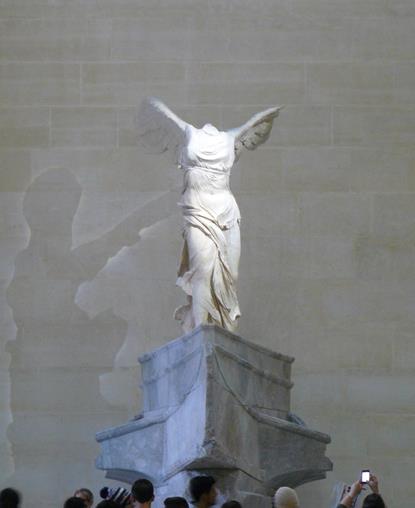Click Play for the Olympic Fanfare and Theme by John Williams:
On Day 10 of the 19-day Winter Olympics, a few questions come to mind:
- What are they doing with that little broom in Curling?
- What on earth is Skeleton?
- What on slopes is Super G?
- Rifles and skis? Really?
The questions are kind of rhetorical, but we do want answers. First, let’s talk about the Olympics and art & design. You’ll see some new content soon (architecture in Beijing, for example) but, especially for readers who subscribed after the Tokyo 2020 Summer Olympics, Iet’s revisit our post from July 2021 about the Original Olympians. (By the way, the answers are at the end.)
The Original Olympians
After waiting an extra year, the world will soon focus on Japan for Tokyo 2020, the Games of the XXXII Olympiad. Not really sure why we use Roman numerals for a Greek event, or for the Super Bowl for that matter, but I digress.
These Games are unusual. First, we wondered if they would be held at all. And now that the 11,000 athletes are ready to compete, it is hard to imagine the Games without spectators. But given that the first Games were held almost 2,800 years ago, it is reasonable that they change from time to time. Surely the Games did not start out like ours.
Greek mythology says that “Olympics” refers to Mount Olympus, the home of the greatest Greek gods and goddesses. And that Zeus, king of the gods, created the first Olympic Games. With just one more week to go before our Olympics, let’s begin a look at the residents of Mt. Olympus in five artworks that deserve medals.
#5 – Participation Trophy
The subject of our first artwork is the son of the river god Cephissus and the nymph Liriope. He didn’t have real estate on Mt. Olympus, but since he tried his best, let’s give him a participation trophy. Some people say those trophies promote narcissism. Well, here’s proof.

#5 is Narcissus painted by Caravaggio in 1597-1599. In this painting, the Baroque Italian artist sums up the story of the hunter Narcissus, a handsome youth who rejected the embrace of a nymph, causing her a lifelong heartache. Nemesis, the goddess of revenge, lured him to a pool. When he saw his reflection, he thought it was a beautiful person and fell so in love with it, he could not leave, unto his death.
Caravaggio used chiaroscuro (Italian for light-dark) in his paintings to create drama. Here the brilliant light draws us into the scene, to the youth as a real person, not a mythical figure. In our day, narcissists are unpleasant people, but Caravaggio paints a sympathetic scene. I feel for the young man because I can sense the power of the gaze that holds him, and I can believe he does not realize he is looking at himself.
#4 – Runner Up
If our next artwork still existed, it might have taken the gold. The Statue of Zeus at Olympia was sculpted by Phidias around 435 BC, commissioned by the people in charge of the Olympic Games to go in their Temple of Zeus. The ancient games were held to honor Zeus, known by the Romans as Jupiter.

Statue of Zeus, from a book by Quatremere de Quincy, 1815.
At over forty feet tall, its size alone made it one of the Seven Wonders of the Ancient World. For comparison, Honest Abe in the Lincoln Memorial is nineteen feet tall, and even that size creates a sense of awe. The statue lasted around 900 years. It was taken apart in Olympia and moved to Constantinople where it probably succumbed to fire. It was not made of marble; instead it had a wood frame covered in ivory and gold and decorated with precious stones. The throne included painted figures. The statue was regularly covered with a protective coat of olive oil that pooled below, creating a reflection that made the statue look even bigger. Writers described seeing the statue as a moving experience.
#3 – Bronze
The next artwork is one of the world’s most recognized sculptures. You know a sculpture is popular when you can find copies everywhere, from other museum’s gift shops to a fountain at the Caesar’s Palace casino. The Winged Victory of Samothrace, also called the Nike of Samothrace,was created in Greece around the 2ndThe next artwork is one of the world’s most recognized sculptures. You know a sculpture is popular when you can find copies everywhere, from other museum’s gift shops to a fountain at the Caesar’s Palace casino. The Winged Victory of Samothrace, also called the Nike of Samothrace, was created in Greece around the 2nd century BC and is displayed in a grand setting at the Louvre.



Two photos by Lyokoï88, CC BY-SA 4.0 <https://creativecommons.org/licenses/by-sa/4.0>, via Wikimedia Commons. First of the two cropped by Art and Design 101.
The marble statue honors the goddess Nike and celebrates a battle victory, but which battle is disputed. She is about 8 feet high, only a fifth the size of Zeus, but large enough to be inspirational. We sense her motion as she lands in the wind, motion frozen in time by the mastery of the sculptor.
When dug up in 1863, she was missing her right wing; it was replaced with a copy of the left wing. When we focus on her wings, we barely notice that her arms are broken off. And we are so used to seeing Nike with her head broken off too that I wonder if we would like the sculpture as much if it had a head. A face might connect her to a place and time, taking away from her timelessness and universality. Sometimes a statue has to lose appendages to gain fame. Just ask Venus de Milo.
In our next post we will award the Silver and Gold medals. And as the Olympics continue, we will have fun with artworks about sports.
Let the games begin!

1. Curling is a very labor-intensive sport, taking four players on a team to deliver eight stones. A “brush” is used to sweep in front of the stone to warm the surface of the ice for more distance. Sweeping can also change the stone’s trajectory. Each player has a brush, and each player’s shoes have one gripping sole and one slippery sole. (You can’t make this stuff up!) With Curling in winter, maybe we’ll soon see Cornhole in the Summer Games.
2. Skeleton is a sport in which you lie on a small sled that resembles a skeleton and slide down the track headfirst. This sliding sport is slower than bobsled and luge. With your nose traveling 80 mph several inches above the ice, that’s a good thing.
3. G stands for Giant Slalom.
4. Yes, really. The Biathlon is a cross-country skiing race in which the athletes stop now and then to shoot rifles at targets. Maybe this is the origin of multitasking.

What an interesting topic! I really enjoyed this perspective. I also loved being reminded of the beauty of Caravaggio’s work. I was not familiar with Nike. So beautiful!